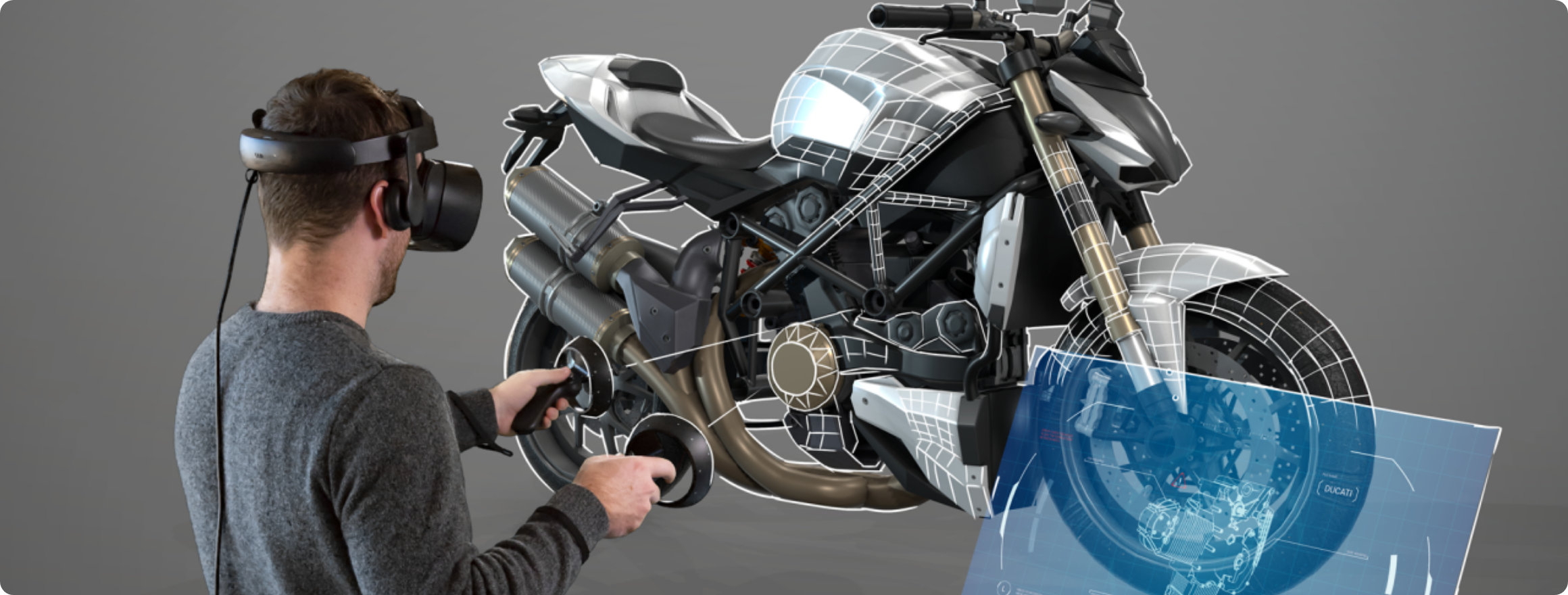
Design influences a product’s lifecycle performance and cost, starting from its development. Product development costs rise significantly if a defect is identified at a later stage. Using virtual tools for new product introduction simulates possible scenarios upfront for comprehensive testing. It gets products to the market quickly and saves money for a successful launch.
Insights
- Design influences a product’s lifecycle performance and cost, starting from its development.
- Conceptualization and design stages determine more than 70% of a product’s lifecycle decisions and cost.
- Virtual tools are an effective way to design new products that serve specific customer needs.
- Virtual models of new products accelerate their evaluations to shrink the development cycle time.
- Organizations should create virtual replicas of workplaces for human-machine interactions studies from multiple perspectives.
Lifecycle cost is the total cost (direct and indirect) a product incurs in its life span. Conceptualization and design stages determine more than 70% of a product’s lifecycle decisions and cost.1 The earlier an issue is identified, specifically in the design stage, the easier it is to fix and avoid costly rework. Virtual replicas (or digital twins) of products, processes, and environments streamline design and new product development to reduce costs and time to market.
A common assertion is between 80% and 90% of new products fail. However, realistic failure rates vary by industry, from 36% in healthcare to 45% in consumer goods.2 Professor Clayton Christensen, best known for his theory of disruptive innovation, believes the success mantra is to design products that serve its intended customers. Manufacturers should focus on the function that a customer who buys a product would want it to do.3
To enable that, virtual representations of the product under development, in orchestration with humans and other entities in the ecosystem, is an effective approach. The approach encourages innovation. Designers visualize the product’s operating condition, create digital prototypes for trial runs, and carry out tests on a global scale. Virtual tools like 3D computer models and digital twins support informed decisions in early product design stages. This mitigates the risk of a wrong product release or a poor customer experience.
→ Virtual products are an effective way to design new products that serve specific customer needs
When end users receive virtual training of a complicated product’s operation (like an aircraft engine), memory retention happens in the background. Any number of such instances can be created at a negligible marginal cost for repetitive usage. A central digital setup saves the cost of setting up multiple physical arrangements at different locations.
PARAMETERS OF SUCCESSFUL NEW PRODUCTS
Product failures are more from a commercial perspective than technical. More than 25% of revenue and profits across industries come from new products, according to a study by McKinsey. Successful products relate to a set of core capabilities, with the top-most as follows:4
- Collaboration to execute tasks as a team.
- Investment to mine market insights and their inclusion in the product.
- Plans for new product launches, comprising target customer segments, key messages to communicate, and objectives to achieve.
- Talent development for new product launches with defined career paths and incentives.
At the same time, the primary reasons for product failures and mitigants are the following:5
- Gap in meeting product expectations; delay launch until product completion.
- Inability to support rapid growth if a product is successful; set ramp-up plans to avoid this.
- Low demand for a new product; perform due diligence for customer requirement before planning a product. Launch products in suitable markets.
- Difficulty in new product usage; provide proper customer orientation and training.
Virtual tools for product design address the above reasons for failure and increase the chances of successful product launches.
DESIGN THINKING WITH VIRTUAL TOOLS
Design thinking is a popular, technology-agnostic approach for new systems design and problem solving. It balances the technical feasibility of products, financial viability, and desirability from a customer’s perspective (see Figure 1). It is even more impactful when implemented along with virtual product design tools.
Figure 1. Design thinking at the sweet spot of desirability, viability, and feasibility
The design thinking cycle starts from empathy to understand a customer’s needs from their perspective, followed by defining, ideating, prototyping, and validating, in iterative loops. New product development and customer participation encourage collaboration in a virtual environment to practice design thinking. Immersive environments using mixed reality (combinations of augmented reality or AR and virtual reality or VR) create a working environment close to the real world, to identify and correct issues much ahead (see Figure 2).
Figure 2. Virtual tools used across design thinking stages
Source: Infosys
→ Virtual models of new products accelerate their evaluations to shrink the development cycle time
Design firm IDEO, for example, wanted to perform ethnographic research to capture customer requirements for new products. However, it was difficult to identify key observations from many data points and recreate them later, even with expensive videos or photos. It addressed the challenge through a VR camera.6
Kaleidoscope Innovation, a design and development unit within Infosys, designed a large freezer project using virtual tools. Such projects usually undergo several time-consuming team reviews. The team created a 3D model in a VR environment that helped designers walk around the product early in the design phase, evaluate its usability from multiple perspectives, and tackle proposed changes to design.
This virtual model did not change the overall project plan, but accelerated evaluation and decisions around it, shrinking the product development cycle time. The team selected the best design without spending time and money on physical prototypes.
CUSTOMER PRODUCT INTERACTION
Mathematical models of an individual product’s performance are important and popular. However, the product should also be ergonomic for safe and productive human-machine interaction. The operations and other associated systems (such as material handling) should be easy to perform. Its ease of making is important for the manufacturer to ensure quality and cost control. The carbon footprint across the lifecycle and its end-of-life disposal should be sustainable.
For example, a hospital has large equipment such as scanners, working in orchestration with other smaller tools, and humans. Room layout is an important aspect of such an infrastructure. Any change post implementation is expensive.
Infosys has created a three-dimensional room planning VR tool. Non-technical sales team members create, change, import layouts, view them from multiple perspectives along with the human and machine elements, and finalize the layout. That final layout is exported as two-dimensional drawings for implementation. This streamlined the sales process and significantly reduced iterations and sales cycle time.
AUTOMATION IN WAREHOUSES
Humans work with machines in warehouses. Material handlers carry out order fulfillment along with pick-and-place robots. Workers’ safety in all situations is important.
A leading e-commerce player wanted to validate design decisions for robots working in its order fulfillment warehouses to gain insights into their safe working alongside humans. Kaleidoscope Innovation created a virtual environment where employees interacted with robots in different situations. The team created a digital twin to simulate several configurations of robots and their working environment. The company recorded the results and interviewed employees about pros and cons of each situation.
The VR-based solution provided a cost-effective and safe way for the e-commerce firm to test new concepts in human-robot interaction and capture data and feedback before implementation. It helped the managers zoom out and look at the big picture, in contrast to one robot or equipment at a time.
TRAINING FOR PRODUCT USAGE
Operators need training to work on machines with complex functionality and procedures, to stay safe and productive. VR-based training prepares humans before hands-on operation on a machine. For instance, Rolls-Royce has rolled out a VR-based training kit for its airline customers to manage aircraft engine maintenance and repair.
Infosys’s VR-based program provides step-by-step instructions to train employees in a hospital environment. The program uses physical gestures to simulate actual tasks involved in a job. Gamification with scores and points keeps employees engaged and motivated. Scores reflect an individual’s strengths and weaknesses. Training data is integrated with the central learning management system for records.
A multinational industrial and consumer goods manufacturer wanted to create an e-training platform for its new operators. It had a few integrated assembly lines for its finished items. The Kaleidoscope Innovation team created a virtual training module along the assembly line, one workstation at a time. The team used front-end user interface elements to guide users for equipment operations. It tracked performance metrics in the backend to provide feedback for correction. Best practices of creating a virtual replica of one workstation are used at later stations.
FUTURISTIC WORKPLACES
While collaborative, remote and hybrid working has surged since the pandemic, the future is in three-dimensional virtual and mixed reality workspaces. Organizations benefit from a virtual 3D replica of its workspaces, equipment, products, avatars, or personas. Employee collaborations lead to faster new product development with effective interactions. Teams share ideas, explore, and invent new concepts. Early collaboration of team members in multiple locations enables them to make more informed decisions in the product development process.
→ Organizations should create virtual replicas of workplaces for human-machine interactions studies from multiple perspectives
The future of work in healthcare, retail, engineering, and manufacturing is where humans and human-like machines work together. Organizations should proactively create such workspaces virtually and study human-machine interaction from safety, productivity, and employee morale perspectives before any physical implementation.
Full article can be found on Infosys.com
References
- Product life cycle cost analysis: State of the art review, Y. Asiedu &P. Gu, 2010, International Journal of Production Research.
- Myths About New Product Failure Rates, George Castellion, Stephen K. Markham, 2013, published in the Journal of Product Innovation & Management 30 pp. 976-979.
- What Customers Want from Your Products, Clayton M. Christensen, Scott Cook and Taddy Hall, January 16, 2006, Harvard Business School.
- How to make sure your next product or service launch drives growth, Alessandro Buffoni, Alice de Angelis, Volker Grüntges, and Alex Krieg, October 13, 2017, McKinsey.
- Why Most Product Launches Fail, Joan Schneider and Julie Hall, April 2011, Harvard Business Review.
- IDEO: Getting closer to the customer through virtual reality, Lauren, April 27, 2017, Harvard Business School.
Back to Insights + News



